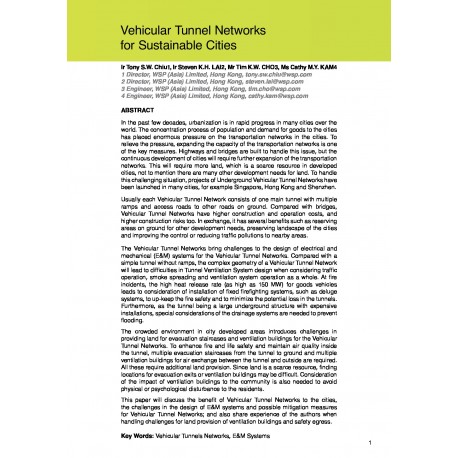Cart
0
0
No document
0,00 €
Total
Document successfully added to your shopping cart
Quantity
Total
There are 0 items in your cart.
There is 1 item in your cart.
Total documents
Total shipping
To be determined
Total
Search & filter
Search for a publication
Search & filter
Viewed documents

Vehicular Tunnel Networks for Sustainable Cities
1821_vehicular_tunnel_networks_f
T. S. W. Chiu / S. K. H. Lai / T. K.W. Cho / C. M. Y. Kam
In the past few decades, urbanization is in rapid progress in many cities over the world. The concentration process of population and demand for goods to the cities has placed enormous pressure on the transportation networks in the cities. To relieve the pressure, expanding the capacity of the transportation networks is one of the key measures. Highways and bridges are built to handle this issue, but the continuous development of cities will require further expansion of the transportation networks. This will require more land, which is a scarce resource in developed cities, not to mention there are many other development needs for land. To handle this challenging situation, projects of Underground Vehicular Tunnel Networks have been launched in many cities, for example Singapore, Hong Kong and Shenzhen.Usually each Vehicular Tunnel Network consists of one main tunnel with multiple ramps and access roads to other roads on ground. Compared with bridges, Vehicular Tunnel Networks have higher construction and operation costs, and higher construction risks too. In exchange, it has several benefits such as reserving areas on ground for other development needs, preserving landscape of the cities and improving the control or reducing traffic pollutions to nearby areas. The Vehicular Tunnel Networks bring challenges to the design of electrical and mechanical (E&M) systems for the Vehicular Tunnel Networks. Compared with a simple tunnel without ramps, the complex geometry of a Vehicular Tunnel Network will lead to difficulties in Tunnel Ventilation System design when considering traffic operation, smoke spreading and ventilation system operation as a whole. At fire incidents, the high heat release rate (as high as 150 MW) for goods vehicles leads to consideration of installation of fixed firefighting systems, such as deluge systems, to up-keep the fire safety and to minimize the potential loss in the tunnels. Furthermore, as the tunnel being a large underground structure with expensive installations, special considerations of the drainage systems are needed to prevent flooding.The crowded environment in city developed areas introduces challenges in providing land for evacuation staircases and ventilation buildings for the Vehicular Tunnel Networks. To enhance fire and life safety and maintain air quality inside the tunnel, multiple evacuation staircases from the tunnel to ground and multiple ventilation buildings for air exchange between the tunnel and outside are required. All these require additional land provision. Since land is a scarce resource, finding locations for evacuation exits or ventilation buildings may be difficult. Consideration of the impact of ventilation buildings to the community is also needed to avoid physical or psychological disturbance to the residents.


